
|
 |

|
 |
Ramli Ibrahim: Preparing Odissi for the 21st century - Lalitha Venkat, Chennai October 10, 2008 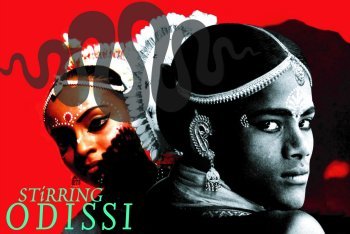 Ramli Ibrahim is trained in Bharatanatyam, Odissi, Western Ballet and Contemporary styles. He dances, teaches, writes and organizes. In conjunction with Sutra's 25th Anniversary, Ramli Ibrahim and Sutra Dance Theatre organized Stirring Odissi 2008, an international festival dedicated to Odissi, in the first ever extensive exposition of Odissi in Malaysia. For three weeks from 23 May - 14 June, 2008, Kuala Lumpur was buzzing with Odissi performances, exhibitions of paintings and photographs, and seminars inspired by Odissi. After his recent successful hectic tour of Europe and the US, Ramli finds time to share his experience as a festival organizer. Check out his candid observations via email with narthaki.com. 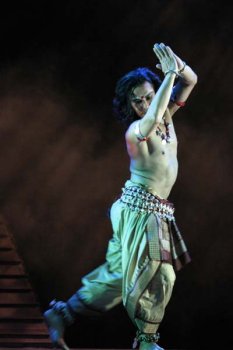 The inspiration to conduct this International Fest in Malaysia... Malaysia needs to see good Odissi performed by the best dancers and to keep in step with recent development in Odissi. There is presently an interesting creative momentum with regard to the development of Odissi world-wide and I felt that Malaysian audience should be exposed to this. It is important for Sutra that Malaysian audience grows as the genre evolves. This will cultivate more discerning and appreciative sensibilities. Art evolved with its time and so should its audience. This interactive development and promotion of good Odissi is an investment that should be adopted by the Odissi fraternity - a policy which will eventually be good for all concerned. What were the criteria to choose the artistes for Stirring Odissi? If any popular artiste is not featured in a fest, there is a general hue and cry, especially from Orissa...your comments... Sutra was a participant in the previous international Odissi Festival held in Bhubaneswar (2006) and humbly we learnt what to do and also what not to do in the Malaysian counterpart. It was generally felt that audience of the International Festival in Orissa 2006 suffered from an 'Odissi Overdose' and subsequently resultant 'Odissi Fatigue' from being exposed to too much Odissi. Every dancer, from the good, the bad and the indifferent were given opportunity to perform regardless of their expertise. Many performed the same items during the same program. It was the 'Frankfurt Fair' of Odissi. Though it was an interesting situation where we were able to do a comparative analysis of works of many gurus, dancers, schools and compositions, but there was so much audience could take in one day and one was left mentally and emotionally exhausted. Some audience even resolved not to see another Odissi program again for some time... At the same time, great dancers especially those who had come from afar, did not have sufficient exposure time to really make all that effort of travelling and preparation worth the time and money spent. What the festival lacked was a firm grip of artistic direction which was a tighter grip of the 'menu' and a judicious balance of 'dishes,' so to speak, to savour the Odissi banquet. Thus, the artistic direction was one of the things I addressed in 'Stirring Odissi 2008' Festival in Malaysia. Yes, of course, there will always be those who will be disappointed that they had not been featured but like any other festivals, we were constrained by finance and permissible time to the number of dancers we could present. Naturally when we spent money to invite dancers, they should not come all the way just to give each a ten-minute exposition. They had to be featured well enough so that both audience and performer are satisfied. Unfortunately, even some good dancers had to be left out. 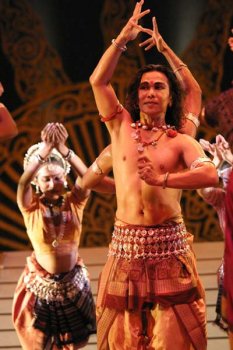 What elements do you think could help modernize Odissi in present times? It is very interesting to look at trends of innovations in present day Odissi. The more innovative Odissi dance-makers predictably come from outside Orissa. This is as expected in view of the more conservative dance milieu in Orissa which discourages the kind of explorations, creative dialogues and experimentations that Odissi dance-makers from outside Orissa are presently engaged in with their own audience. It is not difficult to see how Odissi offers exciting choreographic possibilities and is an inspiration to this new generation of Odissi 'choreographers.' I think the process of 'modernisation' of Odissi, and I mean this in a positive way, will have to come organically. The challenges to stimulate Odissi have to be met on their own terms whether in the use of new movement, choreographic ideas or in music. These have to take into consideration the vision of Odissi in relation to the interaction of its dance makers with their environment and audience. But there are also the other aspects of 'modernisation' of Odissi which are less positive such as the insidious exploitation of Odissi in shoddy dance festivals, the commercialisation of Odissi as a tourist commodity and its subsequent dilution as a dignified and refined classical style. Like other Indian classical dance styles, Odissi also suffers from garishness and tawdry tastelessness as the result of its popularity as it caters for the masses. At the same time we are confronted with essential issues of 'truths' which underlies all art - these are issues in relation to what is perceived as 'authentic', 'beautiful' and 'creative.' In fact, these are some of the most interesting issues discussed in the Stirring Odissi seminar in anticipation for its more active role in the twenty first century. There are so many practitioners of Odissi across the globe. Do you think Odissi is headed in the right direction? No doubt Odissi has become popular but this does not necessarily ensure that Odissi is headed in the right direction. I am not sure that there is sufficient critical mass of good Odissi dancers, dance-makers and discerning arts bureaucrats responsible for its promotion, to ensure that Odissi is heading in the right direction. This was exactly why I thought that it was timely that Malaysia presented an Odissi Festival featuring the best Odissi dancers. This was also the reason that we had a seminar to discuss the manners and ways we could be better prepared to pave the way for Odissi to flourish in the twenty first century. Already in Malaysia unscrupulous dancers and dance teachers have started to open up school to teach 'tawdry' Odissi. Just because one is wearing a bengapatia, that does not make one an Odissi artiste... Would you say there's a kind of rivalry between the Deba Prasad gharana & Kelucharan Mohapatra gharana?? Definitely there is a rivalry between the Deba Prasad and the Kelucharan gharana. It's really not an overt and negative kind of rivalry but there is a certain amount of sibling envy on the part the Deba Prasad practitioners that the Kelucharan Odissi school are thriving while they feel that theirs have somehow missed the boat. Certainly this situation is true outside Orissa! The Kelucharan Odissi fraternity have gotten their act together and flourished all over the world whereas that of the Deba Prasad parampara suffers from a lack of concerted effort and vision to make their presence felt. Generally, there is a lot of in-fightings and the Deba Prasad dancers and teachers are rather fragmented in their efforts to popularise their gharana. Having said that, Malaysia is unique in that the Odissi known here is mainly of the Deba Prasad 'school.' 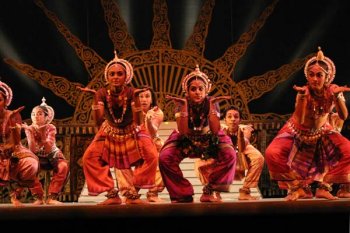 It is said that conferences in general do not achieve anything beyond the conference itself...how different has Stirring Odissi been? One can't really tell as yet if the Stirring Odissi conference would have a more lasting effect than other similar meets. In designing the Seminar for instance, I try to stir away from the all too familiar topics of the past and instead, look at the future - after all, the thrust of our discussion was 'Preparing Odissi for the 21st century.' Right from the beginning, we have constrained the parameter of Odissi to expositions and discussions in line with contemporary traditional repertoire rather than modern works inspired by the Odissi tradition. The latter has a far wider scope which requires its own festival. By limiting it to traditional Odissi or those 'neo-classical' works which abide to what is collectively perceived as 'traditional,' I think we were able to be more focused and discriminating. We must know where we stand - whether we are functioning 'within' the tradition (in which we are responsible for the tradition), or functioning 'outside' the tradition (in which the individual is responsible for his/her artistic statement). With this parameter in mind and with the exposure to good creative Odissi works, we hope that the discerning dance-makers and dancers would have positive reference points for future artistic visions contributing positively to an evolving and dynamic global tradition. I also hope that the Stirring Odissi seminar was effective in many other aspects. There was genuine participation from all concerned and I feel that the democratic atmosphere of the seminar encouraged a more enquiring and even audacious views into the open. This might not have been possible in a less open-minded environment. There was a balance of senior, middle and young artistes and scholars in this festival. There was an interactive and positively liberal atmosphere, generous give and take and palpable camaraderie as participants rehearsed, performed and ate together. They seemed to know where they stood in the general creative order of things without having to be told...a subtle education process was underway which, we hope, would have an indelible effect on their future works... 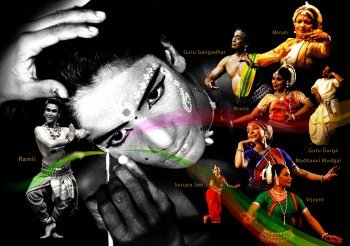 With the fest featuring performances, seminar, exhibition and so on, a lot of organizing had to be done...how did you cope with that? We had to prepare almost two years in advance. I prepared the general artistic direction of the Festival and consulted our advisors. I gathered my collaborators and senior dancers and I told them what we aimed to do and started to prepare them for their various responsibilities such as coordination of artists, gathering of texts for souvenir program, exhibitions and seminar; accommodation; travel and transport etc. In fact, the festival was mainly run by Sutra senior dancers. There was also the aspect of coordinating sponsorship of government agencies of Malaysia (Arts and Culture; Tourism and Foreign Ministries) and India (ICCR, Sangeet Natak Akademi and Department of Culture, Government of Orissa). Without the imprimata of these governmental bodies, I don't think we could do the festival as the bureaucratic requirements were simply too daunting. The tough coordinating job and negotiating international travel, remuneration etc was mainly done by myself. Don't forget there are three major aspects of the Festival such as the performance (which has its on categories: gotipua, male solo, female solo and group); the exhibition and lastly the seminar. Each area had its own special requirements and date lines. There were also aspects of real sponsorship, PR and publication etc which were shared with a professional arts management company. Only in the last three weeks, we were able to secure a title sponsor - Maxis. With this confirmation, we knew that we had it made! A festival of this magnitude needs a lot of financial support...have you recd encouraging responses for this fest? We were first heartened by the successful negotiation with cultural government agencies from Malaysia and India and not forgetting Galeri Petronas (which sponsored the grand exhibition and seminar). These government and quasi-government agencies (and hotel) gave us the initial partnership in providing the venues, travel and accommodation sponsorship. However, we also needed sponsorship in terms of hard cash to pay for other services. We did not manage to secure this until the nth hour with the confirmation of MAXIS as our title sponsor. Do you plan to make it an annual event? Are you kidding? It would be suicidal to make this an annual event! It is the ultimate selfless sacrifice where one is always in the vulnerable position of being a victim and assassinated! In fact, when one is organizing a festival, one is in the unenviable position of 'preparing the banquet' rather than enjoying the party...never again! Ramli Ibrahim can be contacted at: sutradancetheatre@yahoo.com |